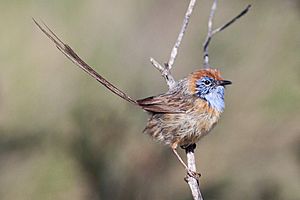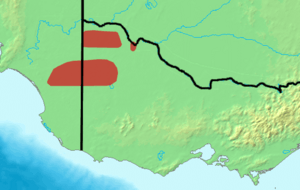Mallee emu-wren facts for kids
Quick facts for kids Mallee emu-wren |
|
|---|---|
 |
|
| Conservation status | |
| Scientific classification | |
| Genus: |
Stipiturus
|
| Species: |
mallee
|
 |
|
| Distribution of the mallee emu-wren | |
The mallee emu-wren (Stipiturus mallee) is a small bird that belongs to the Australasian wren family. This special bird lives only in Australia. Its natural home is in temperate grassland areas. Sadly, it is in danger because its habitat is being lost.
Contents
About the Mallee Emu-Wren
The mallee emu-wren is one of three types of birds in the Stipiturus group, which are all called emu-wrens. Archibald James Campbell first described this bird in 1908. Its common name comes from its tail, which looks a lot like the feathers of an emu.
What Does the Mallee Emu-Wren Look Like?
The mallee emu-wren is about 16.5 centimeters (about 6.5 inches) long from its head to its tail.
Male Mallee Emu-Wren
The adult male has olive-brown feathers on its back with dark stripes. Its head is a pale reddish-brown without stripes. Its wings are grey-brown. It has a bright sky-blue throat, upper chest, and blue patches near its eyes and ears. These blue patches have black stripes. There are also white stripes under its eyes.
Its tail is long, but not as long as other emu-wrens. It has six thin, hair-like feathers. The two middle feathers are longer than the others. The bird's belly is pale brown. It has a black beak and brown feet and eyes.
Female Mallee Emu-Wren
The female mallee emu-wren looks similar to the male, but it does not have the blue feathers. Its head is a lighter red, and it has white patches near its eyes. Its beak is dark brown.
All mallee emu-wrens change their feathers once a year after they breed. They only have one type of feather pattern. The most unique thing about them is their six emu-like tail feathers. This makes them easy to spot among other birds in their home area.
Where the Mallee Emu-Wren Lives
The mallee emu-wren lives only in open mallee woodlands. These woodlands have a special type of grass called spinifex growing underneath the trees. You can find them in north-western Victoria and south-eastern South Australia.
Spinifex Grass: A Perfect Home
This area has a lot of Triodia grass, also known as spinifex. This grass often grows up to 1 meter (about 3 feet) tall. It creates the best home for the mallee emu-wren.
Population Status
The mallee emu-wren was once listed as "vulnerable." But recent studies show its numbers are dropping much faster. Because of this, its status was changed to "endangered" in 2008. The Australian government also lists it as nationally endangered.
Today, there are only about 4,000 of these birds left. Even though they are spread out in the Murray Sunset Reserve (which is about 488 square kilometers or 188 square miles), their homes are in scattered patches. Recent studies found them in more places than thought before. However, they are much rarer in the southern parts of the reserve. Their spread is strongly linked to where Triodia grass hummocks grow. This grass is very important for where the mallee emu-wren lives.
Mallee Emu-Wren Behavior and Diet
Like all emu-wrens, the mallee emu-wren is hard to see because it hides deep inside clumps of spinifex grass. These birds are not very good at flying. Their diet is mostly made up of insects, like beetles, along with seeds and some plant parts.
Reproduction and Nests
Not much is known about their breeding habits. However, they have been seen breeding between September and November. Their nest is shaped like a dome and is built from grasses. They usually hide their nests deep inside a spinifex clump.
Females lay two or three oval-shaped eggs. These eggs are about 13.5 to 16 mm long and 10 to 12 mm wide. They are white with reddish-brown spots, especially at the larger end.
Threats to the Mallee Emu-Wren
Several things threaten the survival of the mallee emu-wren.
Too Many Fires
The plants in their habitat change after a fire. When the plants are 30 years old after the last fire, they are no longer good for the mallee emu-wren. The largest groups of these birds are found in areas that had a fire less than 16 years ago. While occasional fires can be good, too many wildfires or controlled burns are harmful to the birds.
Climate Change
Temperature and rainfall are two main climate factors that affect how well mallee emu-wrens breed. Studies show that if the average temperature changes by just 1 degree Celsius (about 1.8 degrees Fahrenheit), over 90% of the mallee emu-wren's population could disappear. This is a big problem because, since 1997, the Murray Region has had warmer average temperatures each year than usual.
Changes in Land Use
Clearing and burning land for other uses creates small, separate areas where the birds can live. This separation of bird groups has greatly harmed their total population. Farming practices, like letting animals graze, have also reduced the amount of grass in the region. This loss of grass cover is very bad for the mallee emu-wren's home. The low-lying grass provides both their habitat and their food.
Protecting the Mallee Emu-Wren
Many efforts are being made to help the mallee emu-wren. Surveys have been done in places like Billiatt Conservation Park and Ngarkat Conservation Park in South Australia. They have also been done in Murray-Sunset National Park, Big Desert Wilderness Park, and other reserves in Victoria.
Experts have looked closely at the bird's conservation status. They have also studied its habitat and how fires affect it. Plans are being made to help the species recover across Australia and in specific regions.
Sadly, large bushfires in Ngarkat Conservation Park in 2014 made the mallee emu-wren almost disappear from South Australia. However, some birds bred in captivity in Victoria have been released there, and they are showing signs of success.
Images for kids
See also
 In Spanish: Maluro del mallee para niños
In Spanish: Maluro del mallee para niños




